Strain-Mediated Bending of InP Nanowires through the Growth of an Asymmetric InAs Shell
Abstract
1. Introduction
2. Experimental Details
3. Results and Discussion
4. Summary
Author Contributions
Funding
Conflicts of Interest
References
- Duan, X.F.; Huang, Y.; Cui, Y.; Wang, J.F.; Lieber, C.M. Indium phosphide nanowires as building blocks for nanoscale electronic and optoelectronic devices. Nature 2001, 409, 66–69. [Google Scholar] [CrossRef] [PubMed]
- Spirkoska, D.; Arbiol, J.; Gustafsson, A.; Conesa-Boj, S.; Glas, F.; Zardo, I.; Heigoldt, M.; Gass, M.H.; Bleloch, A.L.; Estrade, S.; et al. Structural and optical properties of high quality zinc-blende/wurtzite GaAs nanowire heterostructures. Phys. Rev. B 2009, 80. [Google Scholar] [CrossRef]
- Calahorra, Y.; Ou, C.L.; Boughey, C.; Kar-Narayan, S. Piezoelectric Semiconducting Nanowires. Nanowires Energy Appl. 2018, 98, 445–478. [Google Scholar] [CrossRef]
- Wang, X.D.; Summers, C.J.; Wang, Z.L. Large-scale hexagonal-patterned growth of aligned ZnO nanorods for nano-optoelectronics and nanosensor arrays. Nano Lett. 2004, 4, 423–426. [Google Scholar] [CrossRef] [PubMed]
- Foster, A.P.; Bradley, J.P.; Gardner, K.; Krysa, A.B.; Royall, B.; Skolnick, M.S.; Wilson, L.R. Linearly Polarized Emission from an Embedded Quantum Dot Using Nanowire Morphology Control. Nano Lett. 2015, 15, 1559–1563. [Google Scholar] [CrossRef]
- Calahorra, Y.; Kelrich, A.; Cohen, S.; Ritter, D. Catalyst shape engineering for anisotropic cross-sectioned nanowire growth. Sci. Rep. 2017, 7, 40891. [Google Scholar] [CrossRef]
- Wang, J.; Plissard, S.R.; Verheijen, M.A.; Feiner, L.F.; Cavalli, A.; Bakkers, E. Reversible Switching of InP Nanowire Growth Direction by Catalyst Engineering. Nano Lett. 2013, 13, 3802–3806. [Google Scholar] [CrossRef]
- Tsivion, D.; Schvartzman, M.; Popovitz-Biro, R.; von Huth, P.; Joselevich, E. Guided Growth of Millimeter-Long Horizontal Nanowires with Controlled Orientations. Science 2011, 333, 1003–1007. [Google Scholar] [CrossRef]
- Ben-Zvi, R.; Burrows, H.; Schvartzman, M.; Bitton, O.; Pinkas, I.; Kaplan-Ashiri, I.; Brontvein, O.; Joselevich, E. In-Plane Nanowires with Arbitrary Shapes on Fail Amorphous Substrates by Artificial Epitaxy. Acs Nano 2019, 13, 5572–5582. [Google Scholar] [CrossRef]
- Arbiol, J.; Magen, C.; Becker, P.; Jacopin, G.; Chernikov, A.; Schafer, S.; Furtmayr, F.; Tchernycheva, M.; Rigutti, L.; Teubert, J.; et al. Self-assembled GaN quantum wires on GaN/AlN nanowire templates. Nanoscale 2012, 4, 7517–7524. [Google Scholar] [CrossRef]
- Mussener, J.; Greif, L.A.T.; Kalinowski, S.; Callsen, G.; Hille, P.; Schormann, J.; Wagner, M.R.; Schliwa, A.; Marti-Sanchez, S.; Arbiol, J.; et al. Optical emission of GaN/AlN quantum-wires-the role of charge transfer from a nanowire template. Nanoscale 2018, 10, 5591–5598. [Google Scholar] [CrossRef] [PubMed]
- Kelrich, A.; Sorias, O.; Calahorra, Y.; Kauffmann, Y.; Gladstone, R.; Cohen, S.; Orenstein, M.; Ritter, D. InP Nanoflag Growth from a Nanowire Template by in Situ Catalyst Manipulation. Nano Lett. 2016, 16, 2837–2844. [Google Scholar] [CrossRef] [PubMed]
- Yeh, T.W.; Lin, Y.T.; Ahn, B.; Stewart, L.S.; Dapkus, P.D.; Nutt, S.R. Vertical nonpolar growth templates for light emitting diodes formed with GaN nanosheets. Appl. Phys. Lett. 2012, 100. [Google Scholar] [CrossRef]
- Chi, C.Y.; Chang, C.C.; Hu, S.; Yeh, T.W.; Cronin, S.B.; Dapkus, P.D. Twin-Free GaAs Nanosheets by Selective Area Growth: Implications for Defect-Free Nanostructures. Nano Lett. 2013, 13, 2506–2515. [Google Scholar] [CrossRef] [PubMed]
- Tutuncuoglu, G.; de la Mata, M.; Deiana, D.; Potts, H.; Matteini, F.; Arbiol, J.; Morral, A.F.I. Towards defect-free 1-D GaAs/AlGaAs heterostructures based on GaAs nanomembranes. Nanoscale 2015, 7, 19453–19460. [Google Scholar] [CrossRef] [PubMed]
- Aseev, P.; Fursina, A.; Boekhout, F.; Krizek, F.; Sestoft, J.E.; Borsoi, F.; Heedt, S.; Wang, G.Z.; Binci, L.; Marti-Sanchez, S.; et al. Selectivity Map for Molecular Beam Epitaxy of Advanced III-V Quantum Nanowire Networks. Nano Lett. 2019, 19, 218–227. [Google Scholar] [CrossRef] [PubMed]
- Winnerl, J.; Kraut, M.; Artmeier, S.; Stutzmann, M. Selectively grown GaN nanowalls and nanogrids for photocatalysis: Growth and optical properties. Nanoscale 2019, 11, 4578–4584. [Google Scholar] [CrossRef] [PubMed]
- Sorias, O.; Kelrich, A.; Gladstone, R.; Ritter, D.; Orenstein, M. Epitaxial Nanoflag Photonics: Semiconductor Nanoemitters Grown with Their Nanoantennas. Nano Lett. 2017, 17, 6011–6017. [Google Scholar] [CrossRef]
- Lewis, R.B.; Corfdir, P.; Kupers, H.; Flissikowski, T.; Brandt, O.; Geelhaar, L. Nanowires Bending over Backward from Strain Partitioning in Asymmetric Core-Shell Heterostructures. Nano Lett. 2018, 18, 2343–2350. [Google Scholar] [CrossRef]
- Hilse, M.; Takagaki, Y.; Herfort, J.; Ramsteiner, M.; Herrmann, C.; Breuer, S.; Geelhaar, L.; Riechert, H. Ferromagnet-semiconductor nanowire coaxial heterostructures grown by molecular-beam epitaxy. Appl. Phys. Lett. 2009, 95, 133126. [Google Scholar] [CrossRef]
- Mohan, P.; Motohisa, J.; Fukui, T. Realization of conductive InAs nanotubes based on lattice-mismatched InP/InAs core-shell nanowires. Appl. Phys. Lett. 2006, 88, 013110. [Google Scholar] [CrossRef]
- Kavanagh, K.L.; Saveliev, I.; Blumin, M.; Swadener, G.; Ruda, H.E. Faster radial strain relaxation in InAs-GaAs core-shell heterowires. J. Appl. Phys. 2012, 111, 044301. [Google Scholar] [CrossRef]
- Wallentin, J.; Jacobsson, D.; Osterhoff, M.; Borgstrom, M.T.; Saldittt, T. Bending and Twisting Lattice Tilt in Strained Core-Shell Nanowires Revealed by Nanofocused X-ray Diffraction. Nano Lett. 2017, 17, 4143–4150. [Google Scholar] [CrossRef] [PubMed]
- Hetzl, M.; Winnerl, J.; Francaviglia, L.; Kraut, M.; Doblinger, M.; Matich, S.; Morral, A.F.I.; Stutzmann, M. Surface passivation and self-regulated shell growth in selective area-grown GaN-(Ale,Ga)N core-shell nanowires. Nanoscale 2017, 9, 7179–7188. [Google Scholar] [CrossRef] [PubMed]
- Gagliano, L.; Albani, M.; Verheijen, M.A.; Bakkers, E.; Miglio, L. Twofold origin of strain-induced bending in core-shell nanowires: The GaP/InGaP case. Nanotechnology 2018, 29, 315703. [Google Scholar] [CrossRef] [PubMed]
- Balaghig, L.; Bussone, G.; Grifone, R.; Hubner, R.; Grenzer, J.; Ghorbani-Asl, M.; Krasheninnikov, A.V.; Schneider, H.; Helm, M.; Dimakis, E. Widely tunable GaAs bandgap via strain engineering in core/shell nanowires with large lattice mismatch. Nat. Commun. 2019, 10, 2793. [Google Scholar] [CrossRef] [PubMed]
- Zang, H.; Chen, H.D.; Li, X.L.; Zhao, Y.P. An analytical model for the bending of radial nanowire heterostructures. Phys. Chem. Chem. Phys. 2019, 21, 9477–9482. [Google Scholar] [CrossRef] [PubMed]
- Signorello, G.; Lortscher, E.; Khomyakov, P.A.; Karg, S.; Dheeraj, D.L.; Gotsmann, B.; Weman, H.; Riel, H. Inducing a direct-to-pseudodirect bandgap transition in wurtzite GaAs nanowires with uniaxial stress. Nat. Commun. 2014, 5, 3655. [Google Scholar] [CrossRef] [PubMed]
- Signorello, G.; Sant, S.; Bologna, N.; Schraff, M.; Drechsler, U.; Schmid, H.; Wirths, S.; Rossell, M.D.; Schenk, A.; Riel, H. Manipulating Surface States of III-V Nanowires with Uniaxial Stress. Nano Lett. 2017, 17, 2816–2824. [Google Scholar] [CrossRef]
- Nakamura, K.; Isono, Y.; Toriyama, T. First-principles study on piezoresistance effect in silicon nanowires. Jpn. J. Appl. Phys. 2008, 47, 5132–5138. [Google Scholar] [CrossRef]
- Calahorra, Y.; Shtempluck, O.; Kotchetkov, V.; Yaish, Y.E. Young’s Modulus, Residual Stress, and Crystal Orientation of Doubly Clamped Silicon Nanowire Beams. Nano Lett. 2015, 15, 2945–2950. [Google Scholar] [CrossRef]
- Kelrich, A.; Calahorra, Y.; Greenberg, Y.; Gavrilov, A.; Cohen, S.; Ritter, D. Shadowing and mask opening effects during selective-area vapor-liquid-solid growth of InP nanowires by metalorganic molecular beam epitaxy. Nanotechnology 2013, 24, 475302. [Google Scholar] [CrossRef] [PubMed]
- Kelrich, A.; Dubrovskii, V.G.; Calahorra, Y.; Cohen, S.; Ritter, D. Control of morphology and crystal purity of InP nanowires by variation of phosphine flux during selective area MOMBE. Nanotechnology 2015, 26. [Google Scholar] [CrossRef] [PubMed]
- Hamm, R.A.; Ritter, D.; Temkin, H. Compact metalorganic molecular-beam epitaxy growth system. J. Vac. Sci. Technol. A-Vac. Surf. Film. 1994, 12, 2790–2794. [Google Scholar] [CrossRef]
- Gibson, S.; LaPierre, R. Study of radial growth in patterned self-catalyzed GaAs nanowire arrays by gas source molecular beam epitaxy. Phys. Status Solidi-Rapid Res. Lett. 2013, 7, 845–849. [Google Scholar] [CrossRef]
- Halder, N.N.; Kelrich, A.; Kauffmann, Y.; Cohen, S.; Ritter, D. Growth of wurtzite InP/GaP core-shell nanowires by metal-organic molecular beam epitaxy. J. Cryst. Growth 2017, 463, 10–13. [Google Scholar] [CrossRef]
- Ramdani, M.R.; Harmand, J.C.; Glas, F.; Patriarche, G.; Travers, L. Arsenic Pathways in Self-Catalyzed Growth of GaAs Nanowires. Cryst. Growth Des. 2013, 13, 91–96. [Google Scholar] [CrossRef]
- Calahorra, Y.; Greenberg, Y.; Cohen, S.; Ritter, D. Native-oxide-based selective area growth of InP nanowires via metal-organic molecular beam epitaxy mediated by surface diffusion. Nanotechnology 2012, 23. [Google Scholar] [CrossRef]
- Greenberg, Y.; Kelrich, A.; Calahorra, Y.; Cohen, S.; Ritter, D. Tapering and crystal structure of indium phosphide nanowires grown by selective area vapor liquid solid epitaxy. J. Cryst. Growth 2014, 389, 103–107. [Google Scholar] [CrossRef]
- Froeberg, L.E.; Wacaser, B.A.; Wagner, J.B.; Jeppesen, S.; Ohlsson, B.J.; Deppert, K.; Samuelson, L. Transients in the Formation of Nanowire Heterostructures. Nano Lett. 2008, 8, 3815–3818. [Google Scholar] [CrossRef]
- Genova, F.; Antolini, A.; Francesio, L.; Gastaldi, L.; Lamberti, C.; Papuzza, C.; Rigo, C. Influence of growth-parameters on the interface abruptness in cbe-grown ingaas/inp qws and sls. J. Cryst. Growth 1992, 120, 333–337. [Google Scholar] [CrossRef]
- Algra, R.E.; Hocevar, M.; Verheijen, M.A.; Zardo, I.; Immink, G.G.W.; van Enckevort, W.J.P.; Abstreiter, G.; Kouwenhoven, L.P.; Vlieg, E.; Bakkers, E. Crystal Structure Transfer in Core/Shell Nanowires. Nano Lett. 2011, 11, 1690–1694. [Google Scholar] [CrossRef] [PubMed]
- Larsson, M.W.; Wagner, J.B.; Wallin, M.; Hakansson, P.; Froberg, L.E.; Samuelson, L.; Wallenberg, L.R. Strain mapping in free-standing heterostructured wurtzite InAs/InP nanowires. Nanotechnology 2007, 18. [Google Scholar] [CrossRef]
- Wang, S.Q.; Ye, H.Q. First-principles study on elastic properties and phase stability of III-V compounds. Phys. Status Solidi B-Basic Res. 2003, 240, 45–54. [Google Scholar] [CrossRef]
- Soma, T.; Satoh, J.; Matsuo, H. Thermal-expansion coefficient of gaas and inp. Solid State Commun. 1982, 42, 889–892. [Google Scholar] [CrossRef]
- Glazov, V.M.; Pashinkin, A.S. Thermal expansion and heat capacity of GaAs and InAs. Inorg. Mater. 2000, 36, 225–231. [Google Scholar] [CrossRef]
- Signorello, G.; Karg, S.; Bjork, M.T.; Gotsmann, B.; Riel, H. Tuning the Light Emission from GaAs Nanowires over 290 meV with Uniaxial Strain. Nano Lett. 2013, 13, 917–924. [Google Scholar] [CrossRef] [PubMed]
- Songmuang, R.; Kalita, D.; Sinha, P.; den Hertog, M.; Andre, R.; Ben, T.; Gonzalez, D.; Mariette, H.; Monroy, E. Strong suppression of internal electric field in GaN/AlGaN multi-layer quantum dots in nanowires. Appl. Phys. Lett. 2011, 99. [Google Scholar] [CrossRef]
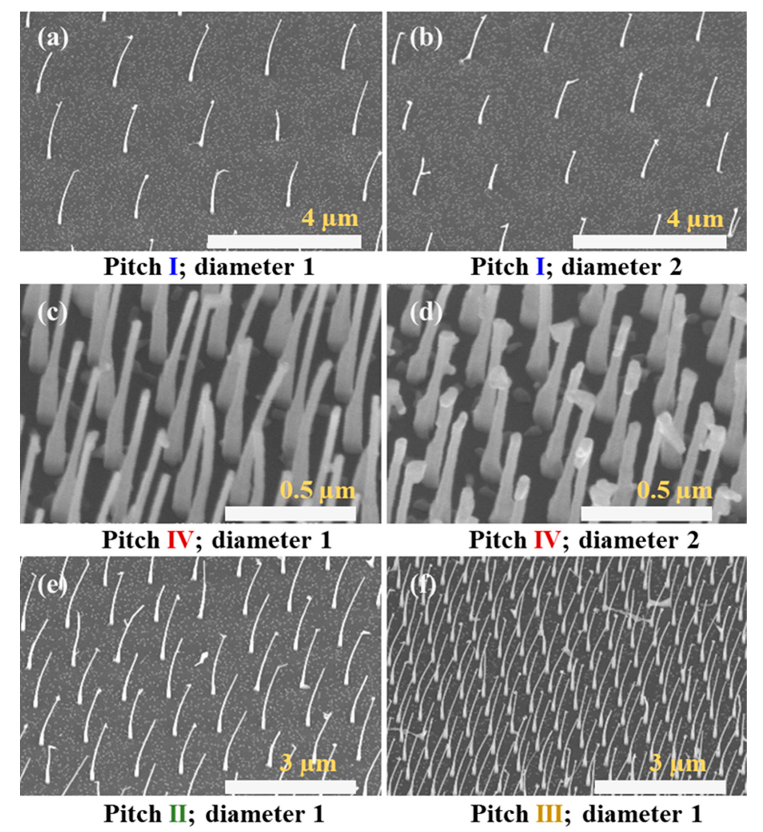
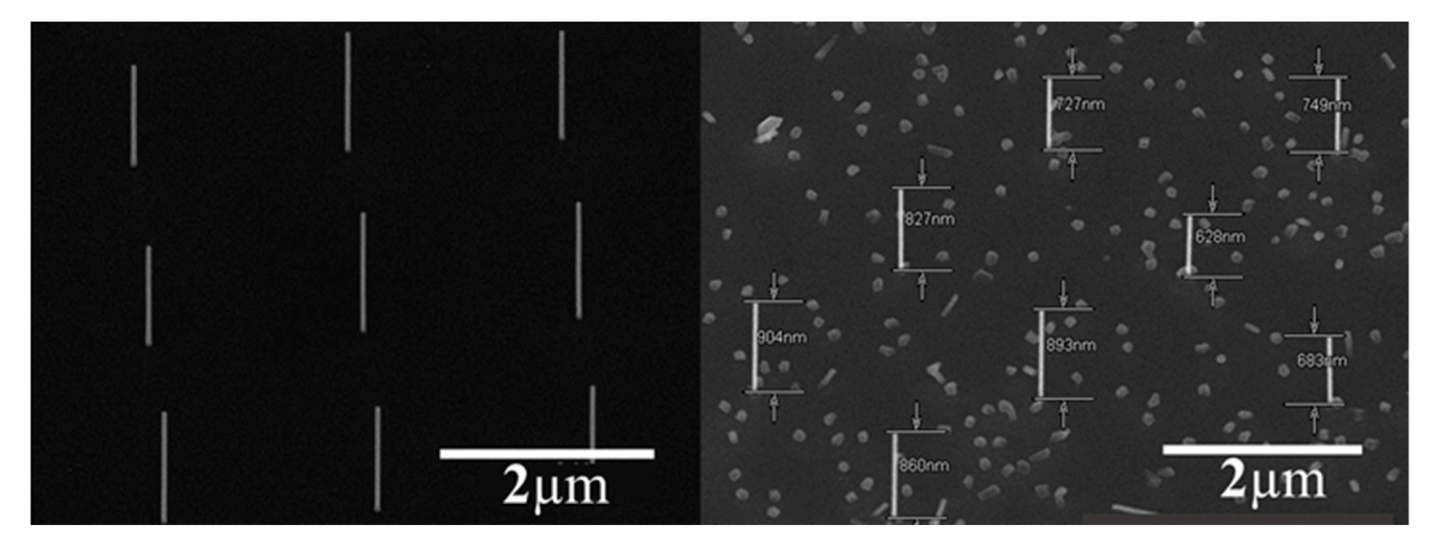
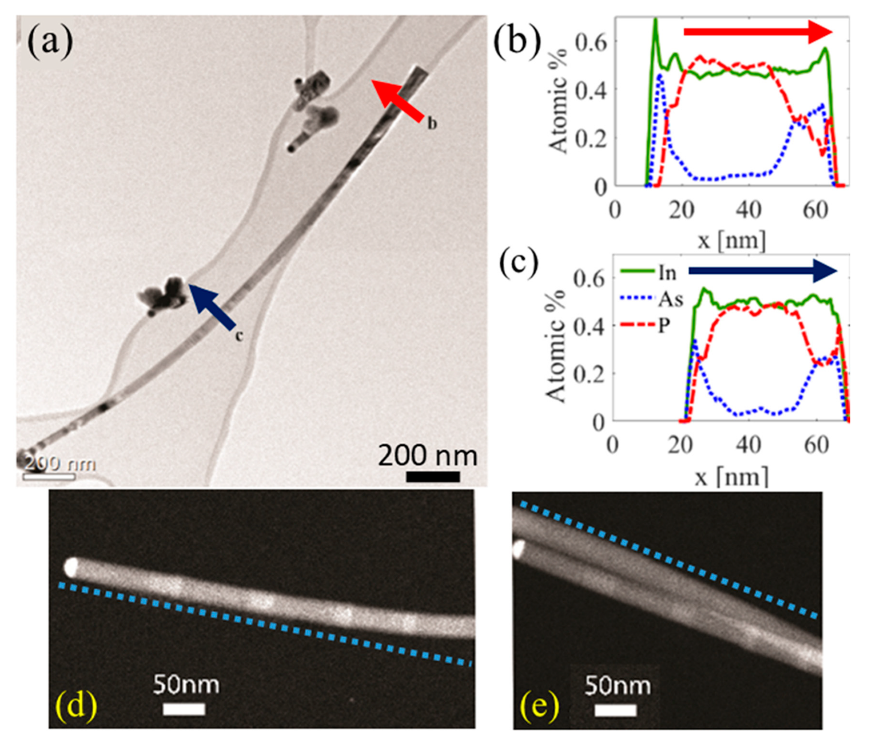
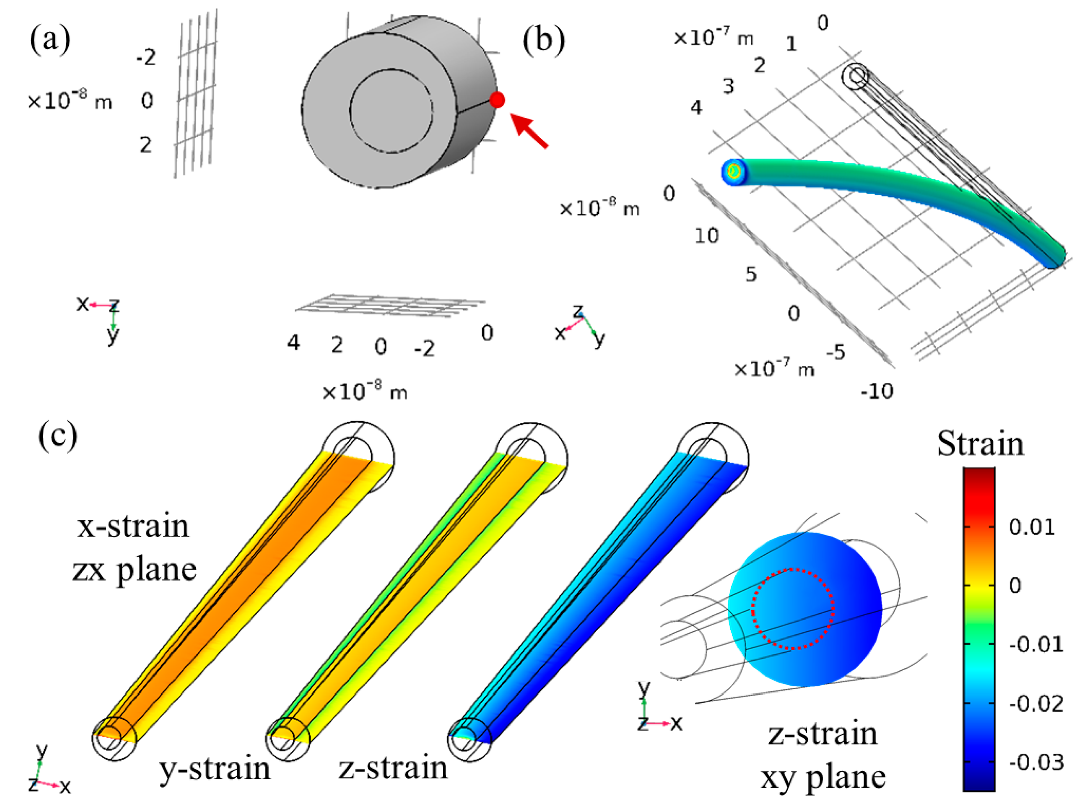
| Shell Composition | Shell Thickness (Thick; Thin) [nm] | Clamping | Radius of Curvature [µm] |
|---|---|---|---|
| InAs | 11; 5.5 | Surface | 6 ± 0.4 |
| InAs | 8; 2 | Surface | 7.5 ± 0.31 |
| InAsP | 11; 5.5 | Surface | 11.6 ± 0.2 |
| InAsP | 8; 2 | Surface | 14.7 ± 0.16 |
| InAs | 11; 5.5 | Point | 7.2 ± 0.08 |
| InAs | 8; 2 | Point | 9 ± 0.07 |
| InAsP | 11; 5.5 | Point | 13.4 ± 0.04 |
| InAsP | 8; 2 | Point | 17 ± 0.04 |
| InAs | Tapered | Surface | 3.7 ± 0.55 |
| InAs | Tapered | Point | 4.8 ± 0.12 |
© 2019 by the authors. Licensee MDPI, Basel, Switzerland. This article is an open access article distributed under the terms and conditions of the Creative Commons Attribution (CC BY) license (http://creativecommons.org/licenses/by/4.0/).
Share and Cite
Greenberg, Y.; Kelrich, A.; Cohen, S.; Kar-Narayan, S.; Ritter, D.; Calahorra, Y. Strain-Mediated Bending of InP Nanowires through the Growth of an Asymmetric InAs Shell. Nanomaterials 2019, 9, 1327. https://doi.org/10.3390/nano9091327
Greenberg Y, Kelrich A, Cohen S, Kar-Narayan S, Ritter D, Calahorra Y. Strain-Mediated Bending of InP Nanowires through the Growth of an Asymmetric InAs Shell. Nanomaterials. 2019; 9(9):1327. https://doi.org/10.3390/nano9091327
Chicago/Turabian StyleGreenberg, Ya’akov, Alexander Kelrich, Shimon Cohen, Sohini Kar-Narayan, Dan Ritter, and Yonatan Calahorra. 2019. "Strain-Mediated Bending of InP Nanowires through the Growth of an Asymmetric InAs Shell" Nanomaterials 9, no. 9: 1327. https://doi.org/10.3390/nano9091327
APA StyleGreenberg, Y., Kelrich, A., Cohen, S., Kar-Narayan, S., Ritter, D., & Calahorra, Y. (2019). Strain-Mediated Bending of InP Nanowires through the Growth of an Asymmetric InAs Shell. Nanomaterials, 9(9), 1327. https://doi.org/10.3390/nano9091327







